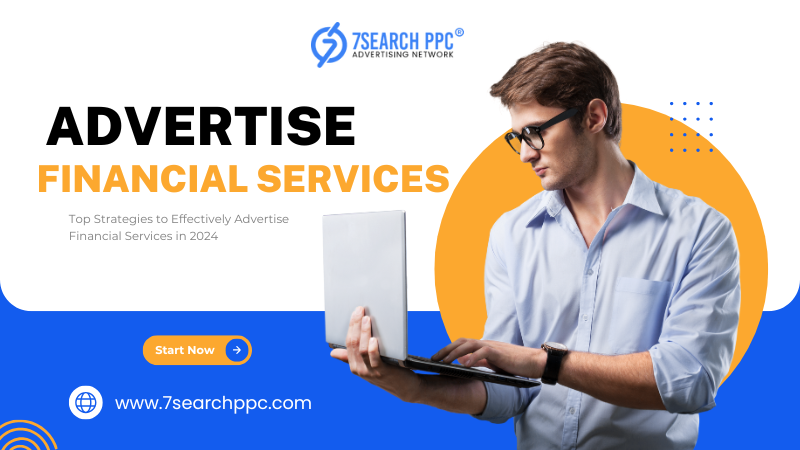Top Strategies to Effectively Advertise Financial Services in 2024

Advertising financial services in today’s digital age requires innovative, client-centered, and compliant marketing strategies. With the financial sector becoming increasingly competitive, standing out demands a blend of authenticity, personalization, and value-driven marketing. In this article, we’ll cover the top strategies to effectively advertise financial services in 2024, with a focus on reaching the right audience through engaging and trustworthy finance ads.
Why Advertising Financial Services Is Essential in 2024
Marketing in the financial sector is more than just promoting services; it’s about building trust and long-term relationships. Financial products can often be complex, making it essential to break down barriers, simplify offerings, and provide value-driven messages. Financial service providers must ensure transparency and credibility to gain customers’ confidence, which is crucial in an industry where trust is paramount.
Key Considerations for Financial Services Advertising
Before diving into specific strategies, it’s essential to consider some unique factors involved in financial services advertising. Unlike many industries, the financial sector is heavily regulated, meaning that financial services ads must adhere to strict guidelines to avoid legal repercussions. Here are a few core considerations:
-
Compliance and Regulations: Financial ads need to meet regulatory guidelines, such as avoiding misleading claims and including necessary disclaimers.
-
Building Trust: Trust is vital in finance ads, as customers are more cautious when dealing with their money.
-
Complex Products: Financial products are often complex, making it essential to present services in a simplified, understandable manner.
Effective Advertising Strategies for Financial Services in 2024
To advertise financial services effectively, a mix of digital channels and strategies is essential. Let’s delve into top approaches that can help financial brands connect with their target audience, build trust, and convert leads into loyal clients.
Utilize Content Marketing to Educate and Engage Customers
The Role of Content Marketing in Financial Services
Content marketing is a powerful way to educate customers, answer their questions, and establish your brand as a trusted authority. In 2024, content that provides genuine value will stand out from competitors. Types of content that work well include blogs, whitepapers, e-books, webinars, and case studies.
Creating Valuable Financial Content
-
Educational Guides: Create in-depth guides that simplify complex financial topics.
-
Case Studies: Share success stories that demonstrate how your services solve real-life financial issues.
-
Frequently Asked Questions (FAQs): Develop FAQ sections to answer common customer questions transparently.
Leveraging Video Content
Video marketing is highly engaging and easily digestible. Explainer videos, webinars, and short social media clips can simplify complex financial topics, making them more accessible.
Invest in Search Engine Optimization (SEO) for Visibility
SEO is essential for financial services advertising, as consumers often turn to search engines for financial advice. Optimizing your website for relevant keywords, such as “financial services ads” and “advertise financial services,” can help attract organic traffic.
Targeting High-Intent Keywords
Focus on keywords that reflect customer intent, such as “best finance ads for retirement planning” or “how to advertise financial services for small businesses.” High-intent keywords align with customers closer to making a decision.
On-Page and Off-Page SEO Strategies
-
On-Page SEO: Optimize meta descriptions, headings, and image alt texts with keywords like “financial services advertising.”
-
Off-Page SEO: Build backlinks from reputable financial websites to enhance credibility and boost search rankings.
Leverage Pay-Per-Click (PPC) Advertising for Quick Results
PPC ads allow financial service providers to reach potential clients quickly by placing ads on search engines, social media, and display networks. Effective finance ads attract immediate attention and can yield impressive results.
Benefits of PPC for Financial Services
With PPC, you can target specific demographics based on factors like location, age, and income, ensuring your ads reach the right audience. Additionally, PPC ads provide measurable results, allowing you to optimize campaigns for higher ROI.
Tips for Creating High-Converting Financial PPC Ads
-
Use Clear CTAs: Guide users toward taking the desired action with clear, concise calls-to-action.
-
Highlight Value Propositions: Focus on benefits such as “low interest rates” or “customized investment plans.”
-
Focus on Retargeting: Use retargeting ads to capture leads who previously visited your website but didn’t convert.
Embrace Social Media Marketing for a Broader Reach
Social media platforms are valuable channels for reaching potential clients and engaging with them directly. However, financial services ads must be crafted carefully on social media to avoid being too promotional.
Choosing the Right Platforms
Each social platform offers unique advantages. LinkedIn is ideal for B2B financial services, while platforms like Facebook and Instagram can help reach a broader consumer base.
Tips for Social Media Finance Ads
-
Provide Informative Content: Share articles, infographics, and educational videos.
-
Run Targeted Ads: Use social media advertising to target specific customer demographics.
-
Engage Through Stories: Share client testimonials and success stories to build trust and engagement.
Email Marketing to Nurture Leads and Build Loyalty
Email marketing allows you to maintain regular communication with prospects and clients. Financial service providers can use email campaigns to offer insights, product updates, and personalized financial advice.
Benefits of Email Marketing for Financial Services
Email campaigns offer a cost-effective way to reach clients directly. They also allow for segmentation, enabling you to send personalized messages based on customer interests and previous interactions.
Building Effective Email Campaigns
-
Segment Your List: Send targeted emails to specific groups, like small business owners or retirees.
-
Focus on Personalization: Use personalized greetings and tailored content to build stronger connections.
-
Automate Drip Campaigns: Develop a series of automated emails that nurture leads over time, such as welcome sequences and product-specific educational emails.
Engage Clients with Targeted Display Advertising
Display ads are visually engaging and help build brand awareness across multiple sites. Using Google Display Network or other ad platforms, you can create finance ads that reach potential clients on websites they frequently visit.
Advantages of Display Advertising
Display ads are effective for creating brand recognition and reaching audiences who may not be actively searching for financial services but could become interested through repeated exposure.
Best Practices for Display Ads
-
Create Attention-Grabbing Visuals: Use professional imagery and graphics that capture attention.
-
Incorporate Trust Elements: Add badges or certifications to build credibility.
-
Include a Clear Call-to-Action: Ensure each ad has a specific action for viewers to take.
Use Retargeting to Convert Potential Leads
Retargeting is an effective way to reach users who have previously shown interest in your services. With retargeting, your finance ads reappear on other websites, reminding users of your brand.
Benefits of Retargeting for Financial Services Ads
Retargeting allows you to stay top-of-mind with potential clients who are in the consideration phase but haven’t converted. This strategy can increase your conversion rate and decrease acquisition costs.
Tips for Effective Retargeting Campaigns
-
Offer Incentives: Retargeting ads offering a free consultation or a downloadable guide can encourage conversion.
-
Use Sequential Messaging: Show different messages over time to move leads through the sales funnel.
Partner with Influencers in the Financial Sector
Influencer marketing has gained traction in the financial services sector. Collaborating with industry experts can increase your brand’s credibility and expand your reach.
Finding the Right Influencers
Choose influencers with a strong reputation in finance and a following that aligns with your target audience. Examples include financial advisors, personal finance bloggers, and investment experts.
Crafting Effective Influencer Campaigns
-
Provide Valuable Content: Partner with influencers to create educational content, such as webinars or Q&A sessions.
-
Sponsor Content on Relevant Channels: Sponsor posts on YouTube or blogs where audiences actively seek financial guidance.
Monitoring and Optimizing Financial Advertising Campaigns
Effectively advertising financial services requires ongoing monitoring to assess performance and optimize your strategies. Here are some key metrics to track:
-
Click-Through Rate (CTR): A high CTR indicates that your ads resonate with the audience.
-
Conversion Rate: Track conversions to see how many ad viewers take the desired action.
-
Return on Ad Spend (ROAS): Evaluate ROAS to understand the financial returns of each campaign.
-
Customer Acquisition Cost (CAC): Monitor CAC to ensure your ad spend remains efficient.
The Importance of Data-Driven Decisions
Use insights from your metrics to refine your financial services ads. Test various ad formats, messaging, and channels to identify what drives the best results for your campaigns.
Conclusion
In 2024, advertising financial services will focus heavily on trust, education, and personalization. Financial service providers must embrace innovative strategies, from content marketing and SEO to influencer partnerships and retargeting. By aligning your approach with compliance standards, understanding your audience, and adapting to the latest trends, you can create finance ads that resonate with clients and drive substantial growth.
Whether you’re just beginning your financial services advertising journey or looking to refine your strategy, remember that the key lies in building trust and offering value-driven solutions. With these strategies in place, your brand will be well-positioned to stand out in a competitive financial landscape.
Frequently Asked Questions (FAQs)
What are the most effective platforms for advertising financial services?
Ans: The best platforms for financial services ads include search engines like Google for PPC campaigns, social media platforms such as LinkedIn (for B2B services), Facebook, and Instagram. Email marketing and content marketing through blogs, case studies, and video content are also highly effective.
How can I ensure my financial services ads comply with regulations?
Ans: Compliance is critical in financial services advertising. Make sure to include all necessary disclaimers, avoid misleading claims, and stay updated on guidelines from financial regulatory bodies. Consulting with a legal expert can also help ensure all content adheres to industry standards.
What types of content work best for advertising financial services?
Ans: Educational content that simplifies complex financial topics works well. Examples include blog articles, how-to guides, case studies, video explainers, and infographics. Such content builds trust and establishes authority in the financial sector.
How important is SEO for financial services advertising?
Ans: SEO is essential because it helps potential clients find your services organically. By targeting high-intent keywords related to financial services and maintaining a well-optimized website, you increase your visibility and attract clients who are actively seeking financial solutions.
More References
Why Is Your Average CPC So High and how to fix it?
What Is The Best CPC Ad Network?
The Anatomy Of An Irresistible Display Ads
Retargeting Ads: Reach your Target Audience With PPC Ad campaign

